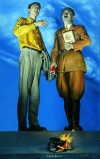
Illustration:
ill. 5.29
Author:
Liu Wei (1963-) 刘炜
Date:
1991 / 1992
Genre:
oil painting
Material:
scan, paper, colour; original source: oil on canvas 100 x 80 cm
Source:
China Avant-Garde 1994: China Avant-Garde, edited by Jochen Noth et al., Heidelberg: Brausdruck, 1994; Oxford: Oxford University Press, 1995:245.
Courtesy:
Liu Wei, Galerie Urs Meile
Keywords:
Mao Zedong, Maoist past, selfportrait, Mao portrait, Cultural Revolution, lost generation, mountains, clouds, China Avant-Garde
Liu Wei: The New Generation (Liu Wei: Xin yi dai 刘炜: 新一代)
In The New Generation 新一代 painted in 1990-91 by Liu Wei 刘炜 (1963-), he uses one of Mao’s official portraits, which is in fact wonderfully red, bright and shining, in all the correct colours, even though the background is slightly schematized with a few too many wonderfully white clouds and wonderfully green trees painted in a decorative style, somehow reminiscent of peasant painting, but caricaturing it at the same time. The Chairman’s figure towers over the composition, and while he remains a “flat poster on the wall” (or perhaps rather, put in the place he had occupied for so long, naturally) the backdrop of the picture (DalLago 1999:52), he is the one who looks the audience directly into their eyes—the little boys, sitting on a bench in front of his portrait, on the other hand, are looking away.
While Mao’s portrait is slightly distorted, one of the eyes is a bit off, portrayed lower than the other, and the nose appears more than usually crooked, he is nevertheless still perfect enough to form a striking contrast with the two boys: they are much more heavily distorted with their strangely patched and many-coloured faces, changing between grey and brownish red and white in colour, thus vividly contrasted with the clear and saturated rich colours in the Mao portrait. Their bizarre hands, with whom they are covering their crotch cannot avoid their genitals from showing, nevertheless, as they are wearing typical Chinese baby pants which are open at the bottom to make nappies unnecessary. This is the “new generation,” (Mao’s “new generation,”) as the title insinuates.
Not unlike the Anyuan parodies by Wang Xingwei (ill. 5.27), this image is, again, a self-portrait, it is said to show the artist and his brother. The two boys are at the center of the picture. What is the message of such a painting, who is the implied audience here? Those frustrated by and incapacitated because of Maoist policies, the so-called “lost generation” of the Cultural Revolution? Probably yes.












































































































